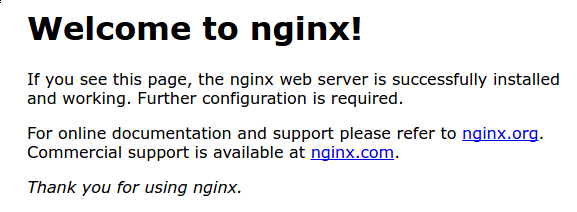Step 1 – Installing Nginx
Because Nginx is available in Ubuntu's default repositories, you can install it using the
apt packaging system.
Update your local package index:
- sudo apt update
Install Nginx:
- sudo apt install nginx
Step 2 – Adjusting the Firewall
If you followed the prerequisite server setup tutorial, then you have the UFW firewall enabled. Check the available
ufw application profiles with the following command:
- sudo ufw app list
Output
Available applications:
Nginx Full
Nginx HTTP
Nginx HTTPS
OpenSSH
Let's enable the most restrictive profile that will still allow the traffic you've configured, permitting traffic on port
80:
- sudo ufw allow 'Nginx HTTP'
Verify the change:
- sudo ufw status
Output
Status: active
To Action From
-- ------ ----
OpenSSH ALLOW Anywhere
Nginx HTTP ALLOW Anywhere
OpenSSH (v6) ALLOW Anywhere (v6)
Nginx HTTP (v6) ALLOW Anywhere (v6)
Step 3 – Checking your Web Server
Check with the
systemd init system to make sure the service is running by typing:
- systemctl status nginx
Output
● nginx.service - A high performance web server and a reverse proxy server
Loaded: loaded (/lib/systemd/system/nginx.service; enabled; vendor preset: enabled)
Active: active (running) since Fri 2018-04-20 16:08:19 UTC; 3 days ago
Docs: man:nginx(8)
Main PID: 2369 (nginx)
Tasks: 2 (limit: 1153)
CGroup: /system.slice/nginx.service
├─2369 nginx: master process /usr/sbin/nginx -g daemon on; master_process on;
└─2380 nginx: worker process
Access the default Nginx landing page to confirm that the software is running properly through your IP address:
http://your_server_ip
You should see the default Nginx landing page:

Step 4 – Setting Up Server Blocks (Recommended)
When using the Nginx web server, you can use server blocks (similar to virtual hosts in Apache) to encapsulate configuration details and host more than one domain from a single server. We will set up a domain called example.com, but you should replace this with your own domain name. To learn more about setting up a domain name with DigitalOcean, see our introduction to DigitalOcean DNS.
Create the directory for
example.com, using the -p flag to create any necessary parent directories:
- sudo mkdir -p /var/www/example.com/html
Assign ownership of the directory:
- sudo chown -R $USER:$USER /var/www/example.com/html
The permissions of your web roots should be correct if you haven't modified your
umask value, but you can make sure by typing:
- sudo chmod -R 755 /var/www/example.com
Create a sample
index.html page using nano or your favorite editor:
- nano /var/www/example.com/html/index.html
Inside, add the following sample HTML:
/var/www/example.com/html/index.html
<html>
<head>
<title>Welcome to Example.com!</title>
</head>
<body>
<h1>Success! The example.com server block is working!</h1>
</body>
</html>
Save and close the file when you are finished.
Make a new server block at
/etc/nginx/sites-available/example.com:
- sudo nano /etc/nginx/sites-available/example.com
Paste in the following configuration block, updated for our new directory and domain name:
/etc/nginx/sites-available/example.com
server {
listen 80;
listen [::]:80;
root /var/www/example.com/html;
index index.html index.htm index.nginx-debian.html;
server_name example.com www.example.com;
location / {
try_files $uri $uri/ =404;
}
}
Save and close the file when you are finished.
Enable the file by creating a link from it to the
sites-enabled directory:
- sudo ln -s /etc/nginx/sites-available/example.com /etc/nginx/sites-enabled/
Two server blocks are now enabled and configured to respond to requests based on their
listen and server_name directives:example.com: Will respond to requests forexample.comandwww.example.com.default: Will respond to any requests on port80that do not match the other two blocks.
To avoid a possible hash bucket memory problem that can arise from adding additional server names, it is necessary to adjust a single value in the
/etc/nginx/nginx.conf file. Open the file:
- sudo nano /etc/nginx/nginx.conf
Find the
server_names_hash_bucket_size directive and remove the # symbol to uncomment the line:
/etc/nginx/nginx.conf
...
http {
...
server_names_hash_bucket_size 64;
...
}
...
Test for syntax errors:
- sudo nginx -t
Restart Nginx to enable your changes:
- sudo systemctl restart nginx
Nginx should now be serving your domain name. You can test this by navigating to
http://example.com, where you should see something like this:
Conclusion
Now that you have your web server installed, you have many options for the type of content to serve and the technologies you want to use to create a richer experience.
If you'd like to build out a more complete application stack, check out this article on how to configure a LEMP stack on Ubuntu 18.04.
Sumber :
0 Response to "Install ssl let's encrypt nginx di ubuntu server PART 1"
Post a Comment